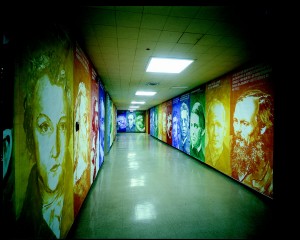Artist’s Museum puts focus on local designs
I first stumbled across photographer and filmmaker Sharon Lockhart’s work as a disinterested middle schooler.
Oblivious to artistic concepts of created fiction spawned by my city’s film industry, I was merely a 12-year-old on a forced field trip to the Museum of Contemporary Art’s Geffen Contemporary building when I was struck by five large-scale photos of adolescents suspended in the moment before a kiss.
The photos’ lighting and dramatic angle alludes to cinematic aesthetics and I was sucked into the emotional expression locked on each of the children’s faces.
Even after I was yanked away and thrown back on the school bus to the San Fernando Valley, the image of children my age acting out intimate moments meant for adults became burned in my memory as the first art piece that I truly connected with.
Twelve years later, on a more informed trip to the same museum, I again came face to face with the current USC professor’s seminal portraits. This time, however, had context.
Titled “Audition One” through “Audition Five,” the photos were back on the walls of MOCA’s Geffen Contemporary as a part of The Artist’s Museum, MOCA’s newest exhibit highlighting more than 30 years of Los Angeles artists who have shaped contemporary art dialogues.
Spread between both the Geffen Contemporary building and the museum’s main Grand Avenue location, the exhibit is not only a comprehensive show-and-tell for Los Angeles’ cultural contributions, but also for MOCA itself.
Mainly culled from MOCA’s permanent collection — with selections on loan from private owners as well as original commissioned works — The Artist’s Museum is a sign of life after nearly two years of financial crisis that cut exhibitions and produced talks of merging the world-class institution with crosstown rival LACMA.
But after a meager 2009 budget brought only one traveling retrospective to the Grand Avenue location (it usually sees four to five), MOCA’s latest homespun show proves that a lack of funds does not mean a lack of creativity.
In drawing from its own massive holdings, The Artist’s Museum proves artists in Los Angeles are leaders in postmodern critique, and places MOCA — as the city’s only museum dedicated exclusively to post-World War II art— at the center of the ongoing conversation.
In addition to Lockhart’s “Audition” series — which was inspired by forced fictions in film — the Geffen Contemporary part of the exhibition houses a multitude of sculpture, mixed-media and video installations from across the visual spectrum.
In one room, a wax superhero sculpture formed out of hubcaps coexists with abstract forms that emulate the growth of oak trees in nature. A collage of Los Angeles Times “Home” section cutouts that facetiously suggests we sell pricey houses to buy aircraft carriers for the government leads museumgoers into a screening room where the tale of a fictional all-girl theatrical prog-rock band (played by ventriloquist dummies) is on a 14-minute loop.
Also on the USC front, Roski School of Fine Arts professor Andrea Zittel installed lab-worthy cages signifying the elite’s need for designer pets while USC alumna Amanda Ross-Ho displayed two pieces newly acquired by the museum that use found images to negotiate the ideas of objectivity and subjectivity.
Compared to the large-scale installation and sculptural pieces at the Geffen Contemporary, the Grand Avenue half of the exhibit is, on the other hand, mostly two-dimensional. Lining the walls are photos, paintings, silkscreens and line drawings from recognizable L.A. artists such as Raymond Pettibon, Robbie Conal, Robert Irwin and Mark Ryden.
The visual contrasts between many of the pieces might make their placements appear haphazard, but they do carry thematic, if not geographic, ties. Raymond Pettibon’s old Black Flag concert fliers, for example, converse with singer Devendra Banhart’s tribal line drawings across the hall to show the different ways that art and music have intersected in the city.
And Long Beach’s post-industrial landscape captured in Bill Viola’s “Anthem” runs well with Long Beach-born Ed Moses’ abstract brush strokes by highlighting how one area of the city can influence different artistic reactions.
Placing local artists in conversation with one another is a first for MOCA, whose recent exhibition, “Collection: MOCA’s First Thirty Years,” attempted to showcase the institution’s international breadth.
And although it’s true that Los Angeles’ penchant for experimentation has made it an international art hub, The Artist’s Museum displays how that environment has affected the city’s own creative community.
By drawing lines of influence and creating new associations between works created since the museum opened in 1979, the exhibition connects several generations of local artists as a way to symbolize MOCA’s own success.
As the institution continues to struggle out of its financial debt, The Artist’s Museum is a reminder of the museum’s importance to both artists and art-lovers in Los Angeles. The inclusion of works previously displayed at MOCA — such as Lockhart’s “Audition” series — easily personalizes this sentiment for anyone who has visited the museum before.
Unlike the previous show, assembled exhibits thrown together in what felt like an attempt to fill space, The Artist’s Museum is full of positivity for the future.
The fact that the presentation is temporary signifies that MOCA is on its way, and with four dynamic exhibitions already slated for next year, the museum appears to be on track to resume its former greatness.
Sarah Bennett is a senior majoring in communication. Her column, “Fake Bad Taste,” ran Wednesdays.

